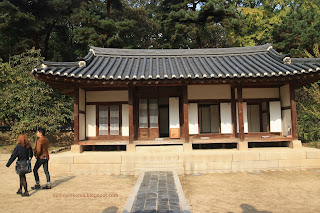You'll never find a quiet spot inside a coffee shop. There will always be a bunch of ajummas gossiping next to you, or Korean girls trying to outtalk each other.
And I bet, you won't even find peace in your own home. The ajussi selling vegetables will blast his loudspeaker from his truck to wake you up and buy his tomatoes or potatoes.
Even up on a mountain, a group of drunk ajussis, with their bottles of soju, will spoil your meditation.
But there are a few spots in Seoul where I am sure you can actually find peace and quiet. How? Because these are places where the occupants are literally resting in peace.
One is the Seoul National Cemetery near Dongjak Station in Seoul's Dongjak District; it's the resting place of heroes, martyrs and honored citizens. Picnics are prohibited here. On a cool autumn day, you can just stroll around the cemetery amidst the changing colors of the foliage. In spring, this place is even less crowded compared to Yeouido, if you want to see some cherry blossoms. Entrance is free. For the living, that is.
Another one in the middle of the city is a royal resting place: the Seongjeongneung in the Gangnam District that consists of two royal tombs.
Seolleung is the royal tomb of the 9th King Seongjong of the Joseon Dynasty and his second wife, Queen Jeonghyeon.
Jeongneung, on the other hand, is the tomb of the 11th King Jungjong, also of the Joseon Dynasty.
This is actually a small forest right in the middle of a busy district, and constructing tall apartment and office buildings around the site is prohibited because Seongjeongneung is both a cultural heritage site and UN Heritage Site. Unlike the rest of Seoul, you won't see shadows of tall buildings encroaching on the perimeter.
What you'll see are trails around and a forest within, and what you'll hear are silence and the occasional singing of the birds. During weekdays, you'd see office people stretching their legs around the site, and on weekends, you'd see couples and families walking around the woods.
(That huge trunk is at least 500 years old)
There's also a 'natural treasure' inside the Seongjeongneung. It's probably the tallest gingko tree I have seen in Seoul. Why it has grown this tall? Because it's at least 500 years old! And if you're there at the right day if the year, it should be in its full autumn yellow glory! There's a marker next to it. This tree is just a few minutes from the entrance. If you're facing the entrance, it's on your right. Since it's very tall, you can actually see it from afar.
(The oldest gingko tree towers above
everything else)
But if you want to be a regular visitor, you can also purchase monthly and annual access passes.
So, if you want to get away from all the chaos and noise of the city, Seongjeongneung should be a new getaway for you.

























No comments:
Post a Comment